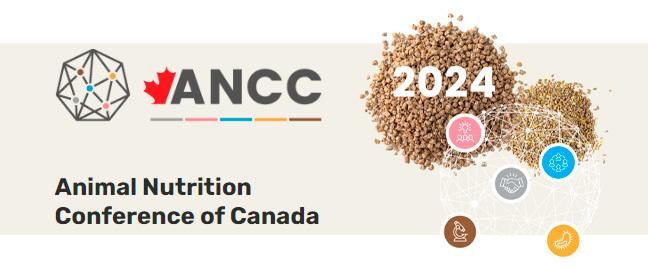Check out what is new in Poultry Industry
Find the best technical articles, forums, and videos on Poultry Industry at Engormix. Enter now and interact with the world's largest agricultural social network.
.jpg&w=3840&q=75)
Dr. Leonie Jacobs (Virginia Tech / Poultry Extension Collaborative) offers insights on poultry welfare and its potential for the future of production systems -and the industry as a whole-, during this Engormix interview....
Comments : 0
Recommendations: 0
This is a call for abstracts for the 2024 Poultry Science Association Latin American Scientific Conference. Abstracts must be submitted in English using the ...
Comments : 0
Recommendations: 0
Recommended events
May 14, 2024
Canada - Manitoba - Winnipeg
_1.jpg&w=3840&q=75)
Frank Ivey (Feed2Gain) shares his experience and insights on diet changes, cost savings in formulations, as well as how the impact of enzymes is evaluated, in this Engormix interview....
Comments : 0
Recommendations: 3
Ottawa, ONTARIO — What impact will global changes have on Canada’s feed industry? How can local solutions help the sector thrive? How can the feed industry address animal nutrition and feed security to build the sector of tomorrow?
Answers to these questions will be at the...
Comments : 0
Recommendations: 0
The holiday season is once again here, which means many kitchens will be filling up with baked goods and savory dishes. It is also the time of year when the use of eggs increases for all of those delicious dishes! However, eggs can be a potential source of Salmonella bacteria that can cause illness or in rare cases even death. Here are some tips to...
Comments : 0
Recommendations: 0
Introduction The United States (US) has three main broiler chicken production systems which mandate that birds have outdoor access. The first is certified organic production overseen by the United States Department of Agriculture (USDA), which requires that birds have access to the outdoors, with shade, shelter, exercise areas, fresh air, direct sunlight, and protection from predators year-round [1]. The second is free-range poultry production, overseen by the USDA, where...
Comments : 0
Recommendations: 0
Introduction Non-typhoidal Salmonella (NTS), one of the principal causes of limiting diarrheal diseases in humans due to the presence of a myriad of virulence determinants, is responsible for approximately 155,000 deaths annually (Pan et al., 2009; Majowicz et al., 2010; Eguale et al., 2015; Balasubramanian et al., 2019; Nale et al., 2021). It is estimated that 93.8 million cases of gastroenteritis caused by Salmonella infection occur worldwide each year...
Comments : 0
Recommendations: 0
Stress is a term which is very commonly used in today’s poultry and livestock rearing. Although the classical school of thought has always considered within the prism of “Heat Stress” which is true and holds its essence in today’s poultry and livestock rearing. However, with the advancement in the rearing of poultry and livestock, there has been lot of measures which have been taken to improve the productive parameters of birds. This has been possible primarily...
Comments : 0
Recommendations: 0
Introduction It is well known that humans need food in order to survive. When all people, at all times, lack physical and financial access to sufficient, secure, and nourishing food that meets their dietary needs and food preferences for an active and healthy life, food insecurity results [1]. According to [2], around 795 million people globally suffer from chronic undernourishment, and Africa is responsible for more than 60% of the world’s food insecurity. With a hunger...
Comments : 0
Recommendations: 0
Rossari Biotech Limited, introduces Protoxy Forte, a groundbreaking solution designed to maximize poultry feed efficiency and production performance. Developed after extensive research and innovation, Protoxy Forte is a highly concentrated, granular protease enzyme derived from Bacillus subtilis, offering unparalleled benefits for the...
Comments : 1
Recommendations: 1
Bright Ideas in Poultry Lighting:
Illuminating species-specific considerations
Thursday May 23rd
9 AM - 12 AM est
via Zoom
Dr. Karen Schwean-Lardner
University of...
Comments : 0
Recommendations: 0
Introduction Nepal’s poultry industry has seen a significant and rapid growth in the last decade, contributing more than 4% to the national gross domestic product (GDP) [1, 2]. Majority of the poultry products are supplied by numerous commercial farms (54% of total poultry production) scattered throughout the country. Backyard poultry also accounts for significant proportion of the total poultry production (46%); poultry meat and eggs are an easy source for protein and...
Comments : 0
Recommendations: 0

Life Rainbow
Effects of Muco-defen® on Clostridium perfringens-induced necrotic enteritis in broilers
Introduction Influenza A viruses (FLUAV) from waterfowl are of global concern. Multiple pandemics have occurred as the product of genetic exchange between FLUAV circulating in humans and the avian reservoir (1). FLUAV contains eight gene segments, two of which encode for the surface glycoproteins hemagglutinin and neuraminidase (HA and NA, respectively). The other six for the internal gene cassette, comprised by the set of polymerases, PB2, PB1 and PA, the nucleoprotein NP, the...
Comments : 0
Recommendations: 0
1. Introduction “Feed-food competition” was defined as “the tensions and trade-offs between two alternative uses for edible crops: direct consumption by humans versus feeding livestock” (1). However, feed-food competition includes the use of production resources, such as land, wild fish, and water, and labor, capital, and ecosystem services. The allocation of these resources between all their possible uses is often determined by which end use is most...
Comments : 6
Recommendations: 1
1. Introduction Campylobacter jejuni has been considered one of the leading causes of human gastrointestinal diseases worldwide, with outbreaks registered both in industrialized and developing countries [1]. Campylobacter spp. colonizes the avian gut in high concentrations with few or no clinical symptoms. Hence, it has been traditionally considered commensal, although a revision of this bacteria–host interaction has been recently proposed [2]. Upon interaction with avian...
Comments : 0
Recommendations: 0
1. Introduction In animal husbandry, antibiotics are principally used to prevent, control, and treat diseases. However, they have also been extensively used as growth promoters [1,2]; this practice has been banned in Europe and the U.S. [3,4] but is still widespread in other regions, especially in rural areas, where farmers tend to depend more on antibiotics. Various countries lack legislative measurements to control antibiotic use. Moreover, farmers are not appropriately...
Comments : 0
Recommendations: 0
Did you know the wonderful properties of thyme? 1. Powerful Antioxidant: Thyme is a natural source of antioxidants, such as flavonoids, promoting cellular resistance, and strengthening the immune system in animals 2. Microbiome Properties: Its ability to control pathogenic...
Comments : 1
Recommendations: 2
Featured comment:
Very good points were raised in this discussion and we see that different approaches are possible. Congrats to all of you. I also would like to add some points that I think we need to take into consideration to better use enzymes: 1-we need to know the amount of antinutritional factors and how they affect each specific feed, for example, soluble Arabinoxylans from one raw material can affect the digestibility of other raw material; 2 - The amount of nutritional factors identified as...
Comments : 74
Recommendations: 26
Lipidos Toledo S.A. (LIPTOSA) expresses gratitude to its partners for the warm reception extended during recent on-site visits around the world.
During these engagements, LIPTOSA engaged in fruitful discussions regarding the current challenges and needs in enhancing laying hen...
Comments : 0
Recommendations: 2
1 Introduction Amino acids are organic compounds containing both amino (—NH 2 ) and carboxyl (—COOH) groups. Due to the presence of asymmetric carbon, all amino acids except glycine exhibit optical activity and exist as D- and L-isoforms or enantiomers (Lehninger et al., 2005). The asymmetric α-carbon imparts chirality, a phenomenon where the molecule is not superimposable to its mirror images in space. Due to this, amino acids except glycine exist in...
Comments : 2
Recommendations: 1




.jpg&w=3840&q=75)



.jpg&w=3840&q=75)

.jpg&w=3840&q=75)



.jpg&w=3840&q=75)








